Basic pawn endings: blocked pawns 3 - no rook pawns
Let us have a look to some basic positions
Opposite king positions.
1. Both kings are on the immediate opposite file beside the blocked pawns. (file 1)
2. Both kings are on opposite sides of the blocked pawns separated by one file.(file 2)
-a- both kings are on critiqual squares
-b- one king is on critical square, the other on a non-critical square
-c- both kings are on non-critical squares
3. Both Kings are on opposite sides of the blocked pawns separated by 2 files.(file 3)
-a- both kings are on critiqual squares
-b- one king is on critical square, the other on a non-critical square
-c- both kings are on non-critical squares
1. Both kings are on the immediate opposite file beside the blocked pawns. (file 1)
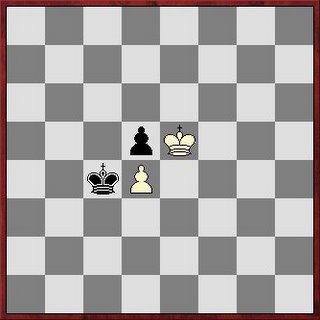
Rule:Whoever moves first, looses the pawn and the game!! Be careful it is an exceptional position.
If Both kings have the same King Pawn distance (equal to 1) than all positions can be handled the same. The two diagrams below are equivalent. it doesn't matter where the black king stands both kings are in striking distance of 1 and cannot protect their own pawn.
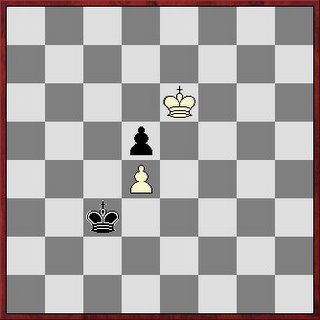
Diagram 1b

Diagram 1c
At first site, it seems that the White king cannot adequate defend his pawn. 1Ke5 and the black king cannot longer protect his own pawn, while white has defended his. White has reached the same position as the exceptional one. It basically comes down that you never want to reach the exceptional pos as the first king but as the last one. Now be being slow earns this time. For once in your live you want to be a turtle king.
General rule: Whoever moves first wins the pawn.
2. Both kings are on opposite sides of the blocked pawns separated by one file.(file 2)

-a- both kings are on critiqual squares
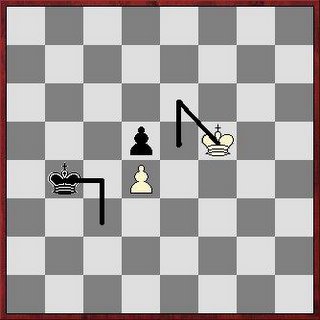
Showing the basic mechanism at work, white to move (remember the red-green square); Note that white plays the turtle King in approach to the pawns. The "direct defense" of the black pawn fails, trying the "opposition defense" fails also coz black is to far away from the opposition square (7-4=3 + 1 =4 coz white can shoulder the black king off, the black pawn will be captured on the second move by the white king). Black will be 2 moves too slow to reach the opposition square when white captured the black pawn.
Rule A: Whoever moves first wins the pawn and the game (coz the defending King is badly placed)
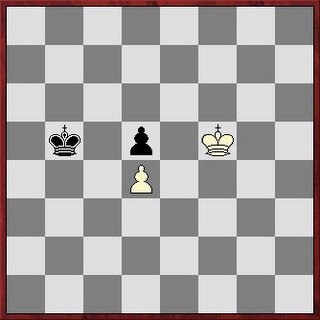
-b- one king is on critical square, the other on a non-critical square

Rule B: Draw - the attacking king can win the pawn but not the game!
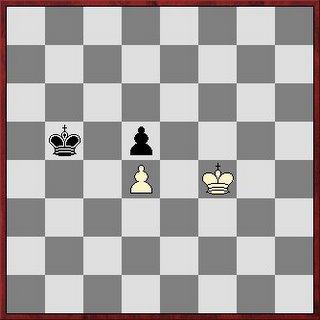
-c- both kings are on non-critical squares
I look to this example in post 4
Rule C: Draw - the attacking king can win the pawn but not the game!
Opposite king positions.
1. Both kings are on the immediate opposite file beside the blocked pawns. (file 1)
2. Both kings are on opposite sides of the blocked pawns separated by one file.(file 2)
-a- both kings are on critiqual squares
-b- one king is on critical square, the other on a non-critical square
-c- both kings are on non-critical squares
3. Both Kings are on opposite sides of the blocked pawns separated by 2 files.(file 3)
-a- both kings are on critiqual squares
-b- one king is on critical square, the other on a non-critical square
-c- both kings are on non-critical squares
1. Both kings are on the immediate opposite file beside the blocked pawns. (file 1)

Rule:Whoever moves first, looses the pawn and the game!! Be careful it is an exceptional position.
If Both kings have the same King Pawn distance (equal to 1) than all positions can be handled the same. The two diagrams below are equivalent. it doesn't matter where the black king stands both kings are in striking distance of 1 and cannot protect their own pawn.

Diagram 1b

Diagram 1c
At first site, it seems that the White king cannot adequate defend his pawn. 1Ke5 and the black king cannot longer protect his own pawn, while white has defended his. White has reached the same position as the exceptional one. It basically comes down that you never want to reach the exceptional pos as the first king but as the last one. Now be being slow earns this time. For once in your live you want to be a turtle king.
General rule: Whoever moves first wins the pawn.
2. Both kings are on opposite sides of the blocked pawns separated by one file.(file 2)

-a- both kings are on critiqual squares

Showing the basic mechanism at work, white to move (remember the red-green square); Note that white plays the turtle King in approach to the pawns. The "direct defense" of the black pawn fails, trying the "opposition defense" fails also coz black is to far away from the opposition square (7-4=3 + 1 =4 coz white can shoulder the black king off, the black pawn will be captured on the second move by the white king). Black will be 2 moves too slow to reach the opposition square when white captured the black pawn.
Rule A: Whoever moves first wins the pawn and the game (coz the defending King is badly placed)

-b- one king is on critical square, the other on a non-critical square

Rule B: Draw - the attacking king can win the pawn but not the game!

-c- both kings are on non-critical squares
I look to this example in post 4
Rule C: Draw - the attacking king can win the pawn but not the game!


2 Comments:
Good post! Is "basic rook endings" a book you are using?
Tempo,
The survival guide to rook endings by Reuben fine is a book I use. For pawn endings I use "A guide to chess endings" by Max euwe. A good book. But i never serious studied rook endings. It is still on my to do list
Post a Comment
<< Home